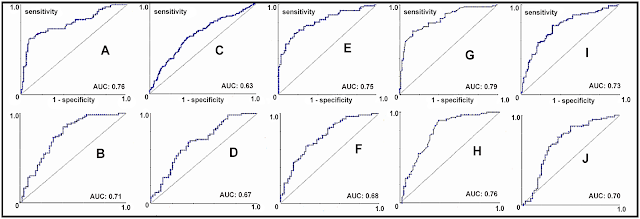Background
Highly
active antiretroviral therapy (HAART) can cause side effects in HIV patients,
as the metabolic syndrome. Early identification of risk for development of
cardiovascular diseases using available reliable and practical methods is
fundamental. On this basis, the aim of this study was to compare the
effectiveness of anthropometric indicators to identify metabolic syndrome in
HIV patients on HAART.
Methods
It
is a cross-sectional study. A number of 280 stable HIV patients were studied.
It measured weight, height, waist circumference (WC), hip circumference (HP),
thigh circumference (TC) and calculated body mass index (BMI), body adiposity
index (BAI), waist to hip ratio (WHR) and waist to thigh ratio (WTR). There was
also a performance of biochemical tests of lipid profile and fasting glucose.
Systemic blood pressure was measured. The criteria proposed by the National
Cholesterol Education Program III (NCEP-ATP III) to metabolic syndrome
classification was used. Individuals were divided in groups with or without
metabolic alterations and their anthropometric indicators were compared.
Receiver operating characteristic (ROC) curves were designed for each
anthropometric indicator using the metabolic syndrome classification to
identify sensitivity and specificity.
Results
WC
was a good tool to identify each metabolic disorder separately: total
cholesterol (only females, p<0.05), triglycerides (only males, p<0.001),
HDL cholesterol (p<0.05), LDL cholesterol (p<005) and fasting glycemic
(p<005). WC also showed the best performance to identify metabolic syndrome
in both genders (areas under the curve (AUCs): 0.79 and 0.76 for male and
female, respectively), while BAI proved to be an inadequate indicator (AUCs:
0.63 and 0.67 for males and females), respectively, in this population.
Conclusions
The central adiposity measure (WC) had the best
performance to identify metabolic syndrome, and it is a convenient, cheap and
reliable tool that can be used in clinical practice routinely to prevent
cardiovascular complications in HIV patients.
Below: Receiver operating characteristic curves for the performance evaluations of anthropometric indicators in identifying metabolic syndrome
Full article at: http://goo.gl/pUIfQT
By:
Department
of Internal Medicine, Ribeirão Preto Medical School, University of São Paulo,
Ribeirão Preto, São Paulo, Brazil
More at: https://twitter.com/hiv insight


No comments:
Post a Comment